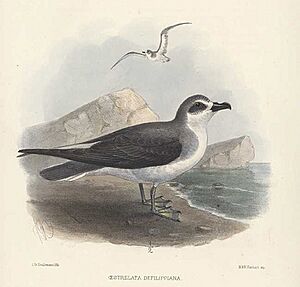Masatierra petrel facts for kids
Quick facts for kids Masatierra petrel |
|
|---|---|
 |
|
| Conservation status | |
| Scientific classification | |
| Genus: |
Pterodroma
|
| Species: |
defilippiana
|
 |
|
The Masatierra petrel (Pterodroma defilippiana), also known as De Filippi's petrel, is a special type of seabird. It belongs to the Procellariidae family, which includes many ocean-dwelling birds. This petrel is found only in Chile. It makes its nests on islands like the Juan Fernández Islands (including Masatierra) and the Desventuradas Islands. These birds love the open sea and rocky shores.
Why is it called that?
This petrel was first described in 1869 by a scientist named Enrico Hillyer Giglioli. He named it to honor another Italian zoologist, Professor Filippo de Filippi. Both scientists were part of a big trip around the world in 1866. Sadly, Professor de Filippi passed away in Hong Kong during the trip. Giglioli then took over the science work for the expedition.
What does it look like?
The Masatierra petrel grows to be about 26 centimeters (about 10 inches) long. It has a dark grey cap and a dark mask around its eyes. Its forehead is white. The top part of its body is dark grey, with a clear "M" shape on its back. It also has a lighter grey collar around its neck. Its throat, belly, and the feathers under its wings are white. When you see it flying from below, its wingtips and the back edges of its wings look black.
Where does it live?
The Masatierra petrel spends most of the year flying over the eastern Pacific Ocean. This area is south of the equator. Here, the Humboldt Current brings up cold, nutrient-rich water from deep in the ocean. This means there is lots of food for the birds. The petrel feeds by flying low over the water and scooping up small creatures.
It comes back to two groups of islands off the coast of Chile to nest. On the Desventuradas Islands, the biggest nesting group is on San Ambrosio. In 1970, scientists thought over 10,000 birds lived there. San Félix island also had about 150 to 200 nesting pairs at that time. On the Juan Fernández Islands, these birds are not thought to nest on Robinson Crusoe Island anymore. However, Santa Clara Island had a few hundred birds in 1991. The number of birds there is not likely to grow much because there are not many good nesting spots left.
Why is it in danger?
The Masatierra petrel lives in the open ocean but returns to islands to breed. It nests on cliff ledges. The total number of these birds might be less than 20,000. Because of this, the IUCN (International Union for Conservation of Nature) lists it as "Vulnerable" on its Red List of Threatened Species. This means it is at risk of becoming endangered.
The main reasons it is vulnerable are its small population and limited nesting areas. Also, animals that live on land, like feral cats and coatis, eat the petrel's eggs and young chicks. These predators are believed to have caused the petrel to disappear from Robinson Crusoe Island. Rats are also thought to be a threat to these birds.


